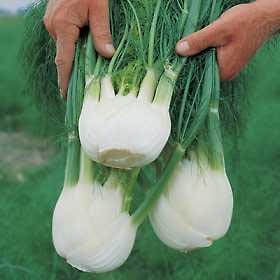
Learning Download: How to Grow Fennel
From Seed to Harvest: A guide to growing fennel.
Fennel is a bulbous vegetable with overlapping layers similar to cabbage and long fronds resembling dill. The fronds can be used in salads, but the vegetable is often grown for its bulb, which produces a crunchy texture with a taste similar to licorice. The bulb can be grilled until tender, or sliced thin for use in slaws and salads.
To plant:
As fennel doesn’t transplant well, plant seeds directly in the garden after the last spring frost. Sow them 1/4 inch deep and 12 inches apart in rows set 3 feet apart. Plant fennel plenty far away from other garden plants to discourage cross pollination. To aid in this, plant fennel in pots or in the back of the garden.
To grow:
Fennel does best in full sun with rich soil, which produces lush fronds. Until the shoots appear, water only by spraying with a spray bottle. After shoots appear, water frequently so the bulb doesn’t dry out. Fennel may need to be staked once it reaches 18 inches tall, as some plants can grow up to 4 feet. The bulb grows at the base of the fronds but not underground. Once the bulb begins to develop, blanch the bulb by hilling soil around it to protect it from the sun.
To harvest:
Fennel is ready to harvest after approximately 90 days. Fennel leaves can be harvested as soon as the plant is well established. Only take a few leaves at a time to not cause harm to the plant. The bulb is ready for harvest once it reaches the size of a tennis ball. To harvest the bulb, cut the fronds from the base of the bulb.
What fennel craves:
Prior to planting the fennel, add a general-purpose fertilizer to the area by following the instructions on the container or mix compost in with the soil. Fertilization while growing fennel is not recommended, as it will lose its aromatic taste if well fed.
Where to buy fennel seeds:
You can find fennel seeds at Urban Farmer.
Learning Download: Common pests and diseases: Fennel
Common pests and diseases: Fennel
When growing vegetables, it is always exciting to care for the plant throughout its growing phase and then harvest it for delicious recipes later on, but one thing to watch out for is pests and diseases. Different plants are susceptible to different types of pests and diseases, and it is important to make yourself aware so you can keep a watchful eye and also take any preventative methods to keep your plants safe throughout their lifespan.
Fennel can fall victim to several different pests and diseases.
Pests:
Aphids, the armyworm and cutworms can be pests that wreak havoc on the fennel plants. Aphids are soft-bodied insects that bring problems to lots of plants. They create discoloration of the leaves, necrotic spots and stunted growth. Use tolerant varieties and only apply insecticides if there’s a high infestation. Encourage lady bugs in your garden to eat the aphids.
The armyworm’s larvae feed heavily on fennel and create skeletonized leaves. Fruit will show shallow, dry wounds. To control these pests, apply Bacillus thuringiensis.
Cutworms will attack plants and then the stems of the young seedlings, or plants that have been recently transplanted, may become severed at the soil line. If the plant is older when the cutworms arrive, there may be irregular holes eaten into the fruit. The larvae are usually only active at night. To prevent this, remove crop debris after harvest and apply a foil collar over the plant’s stem up to 3 inches above the soil line.
Diseases:
Some of the common diseases affecting fennel include Cercospora leaf blight, downy mildew, powdery mildew and rust.
Cercospora leaf blight creates necrotic flecks on the leaves, which will then develop a chlorotic halo and become brown. The lesions will cause the leaves to wither, curl and die. To manage this disease, only plant pathogen-free seeds, rotate crops every year and be sure to plow any crop debris into the soil after you harvest the crops. If necessary, apply fungicide sprays.
Downy mildew causes yellow spots on the tops of the leaves and a white growth on the undersides of the leaves. This disease mostly affects younger plants and is spread by leaves that are consistently wet. To prevent this, be sure not to plant the fennel too close together to allow for good air circulation. Also, utilize crop rotation.
Powdery mildew causes a powder-like growth on the leaves, and the leaves will then become chlorotic. This disease sometimes causes flowers to be distorted. To treat, plant tolerant species and avoid too much fertilizing.
Rust is a green discoloration on the leaves which can then become chlorotic. The plant may then be stunted, and the stems can become distorted or bend. Be sure to plant the fennel in soil that drains well, and apply a fungicide.

